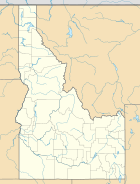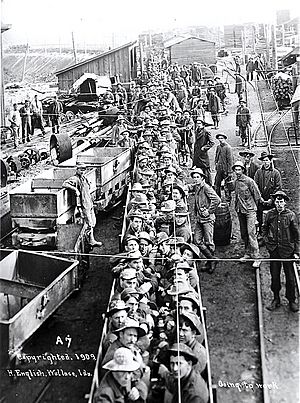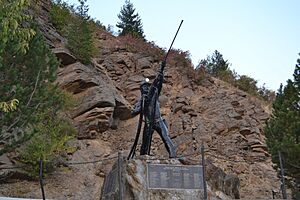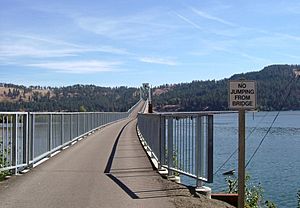Silver Valley (Idaho) facts for kids
Quick facts for kids Silver Valley |
|
|---|---|
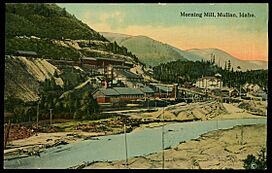
Upper Silver Valley at Mullan in 1909
|
|
| Length | 40 mi (64 km) |
| Geography | |
| Country | United States |
| State | Idaho |
| Counties | Shoshone County, Idaho and Kootenai County, Idaho |
| Population centers | Wallace, Idaho and Kellogg, Idaho |
| Borders on | Bitterroot Mountains and Coeur d'Alene Mountains |
The Silver Valley is a special place in the northwest United States. It is found in the Coeur d'Alene Mountains in northern Idaho. This valley is famous for its long history of mining, which started way back in the 1880s.
Contents
Geography of Silver Valley
The Silver Valley is a narrow valley about 40 miles (64 km) long. It is located east of the city of Coeur d'Alene. The South Fork of the Coeur d'Alene River flows right through the valley. Interstate 90 also runs through it, connecting Fourth of July Pass to the west with Lookout Pass near the Montana border.
Towns in the Valley
Many towns are found in the Silver Valley. All of them are in Shoshone County. From west to east, these towns include Pinehurst, Smelterville, Kellogg, Wardner, Osburn, Silverton, Wallace, and Mullan. Sometimes, people also call this area the Coeur d'Alene Valley or the Coeur d'Alene Mining District.
Rocks and Minerals
The Silver Valley is known for its very old rocks. These rocks formed millions of years ago. They are mostly made of quartzite and argillite, which are types of rock that were changed by heat and pressure.
The valley is rich in important minerals. The main ones found here are galena, sphalerite, and tetrahedrite.
- Galena is a mineral that contains lead. It was the most important ore for lead in the district.
- Sphalerite is a source of zinc. It is found in many of the mines.
- Tetrahedrite is special because it contains a lot of silver. This mineral is why the Silver Valley got its name!
History of Mining in Silver Valley
The search for valuable metals began in Idaho in 1860. Gold was first found in Orofino Creek. This led to a "gold rush" where many prospectors came to the area. In 1883, Andrew J. Prichard found gold in a creek near what is now Murray, Idaho. Soon after, more prospectors came to Burke Canyon looking for gold.
The Northern Pacific Railroad arrived in 1883, making it easier for miners to reach the area. While gold was the first draw, the valley soon became famous for its silver, zinc, and lead.
Miners' Challenges
In the 1890s, miners in the Silver Valley faced tough conditions. They worked hard for low pay and in risky environments. This led to disagreements between the miners and the mine owners.
In 1892, miners went on strike because they wanted better wages. This led to some conflict and the destruction of a mill. The governor sent federal troops to help restore order. Many miners were arrested.
Another similar event happened in 1899. Miners wanted fair pay, especially those at the Bunker Hill and Sullivan mines. Some miners used dynamite to destroy a mill. Again, the governor declared martial law, and many people were arrested to bring peace back to the area.
Major Mines and Disasters
By 1903, Burke Canyon was a very busy mining area. It had seven successful mines, including the Gem of the Mountains and the Hercules mines. Other important mines in the district included the Bunker Hill Mine (1886), Sunshine Mine (1890), and Lucky Friday Mine (1942).
In August 1910, a huge wildfire, known as the Great Fire, swept through the area. It destroyed many towns like Wallace and Kellogg. A brave U.S. Forest Service ranger named Ed Pulaski saved 39 lives by leading his crew into an abandoned mine tunnel.
After WWII, the Silver Valley had many mines and processing plants. The biggest ones were Bunker Hill, Sunshine, Day, Federal, and Hecla.
End of an Era and New Beginnings
The Silver Valley produced a huge amount of metals. Miners found over a billion ounces of silver, 3 million tons of zinc, and 8 million tons of lead! This made the valley one of the top mining areas in the world. In the 1970s, almost half of all silver in the U.S. came from here.
However, mining also had its dangers. On May 2, 1972, a terrible fire at the Sunshine Mine caused the deaths of 91 miners from carbon monoxide poisoning. This was one of the worst mining disasters in American history.
In the early 1980s, most mining stopped. This caused many people to lose their jobs and move away. The valley also faced big environmental challenges from years of mining.
Today, some mining still happens, but the Silver Valley is looking to the future. It is now focusing on recreational tourism and light manufacturing. The valley is working to restore its natural environment, and you can even see tundra swans returning!
Active and Inactive Mines
The Idaho Geological Survey lists some mines in the Silver Valley:
- Active Mines:
- Lucky Friday mine
- Galena Complex (includes Coeur Mine and Galena Mine)
- Inactive Mines (but still have resources):
- Bunker Hill Mine and Smelting Complex
- Sunshine Mine
Outdoor Adventures
The Silver Valley is a great place for outdoor fun!
Skiing
There are two awesome ski areas in the valley, both easy to reach from I-90.
- Lookout Pass is at the east end of the valley, right on the Montana border.
- Silver Mountain is 30 miles (48 km) west, near Kellogg. You can get there by riding the world's longest single-stage passenger gondola!
Biking Trails
Biking is very popular in the Silver Valley for both locals and visitors. There are trails for all skill levels, from easy rides to extreme mountain biking. Silver Mountain has challenging trails you can reach by ski lift.
There are also two major bike paths that use old railroad tracks:
- Route of The Hiawatha: This unique trail starts in Montana and goes downhill through tunnels and over tall bridges. It's named after an old passenger train. One tunnel, called Taft, is over 1.6 miles (2.6 km) long!
- Trail of the Coeur d'Alenes: This paved bike path is more than 72 miles (115 km) long. It starts in Mullan and follows the South Fork of the Coeur d'Alene River through the valley. It even crosses a historic bridge before ending near Plummer.
Images for kids
-
1907 Geologic map of the Silver Valley in Idaho, and the location of the Osburn Fault. Also included are the locations of the towns of Kellogg, Osburn, Wallace and Mullan (west to east).



